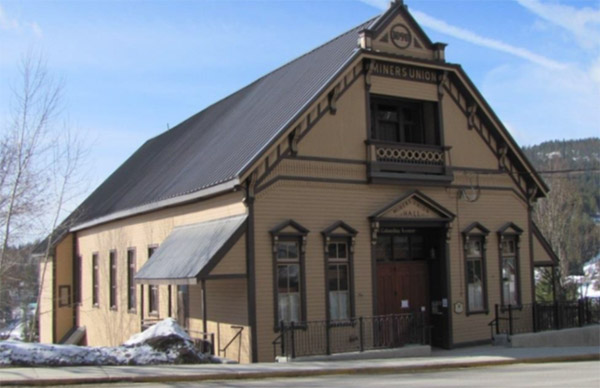Miners’ Union Hall National Historic Site

© Christine Boucher, Parks Canada, 2018
Located at 1765 Columbia Avenue in Rossland, British Columbia, the Miners' Union Hall was built in 1898 to serve as a meeting place for Local 38 of the Western Federation of Miners. This building testifies to the union's determined battle for miners' rights in the region, which led to legislation guaranteeing an eight-hour work day for miners in the province (1899) and contributed to the enactment of the Conciliation Act (1900). A rare surviving building of its type in Western Canada, this eclectic, wooden, late-Victorian Gothic Revival Style building serves as a major landmark for the community. Retaining excellent architectural integrity, it remains an important community meeting place for the people of Rossland. Furthermore, it is a particularly rare and eloquent example in Canada of a building expressly designed to house a union hall.
The Western Federation of Miners (WFM) was a union for metallurgy industry workers in western North America, and Local 38 of WFM, founded in 1895, was the first local in the mining sector in BC. It became one of the most influential and productive in the history of the province. Among other things, the union fought for fair and safe working conditions for miners, and helped pave the way for the union movement in BC. The Miners' Union Hall served as a space for union meetings, and also welcomed various other social and community events. In the 1960s, a new union hall was acquired in the nearby community of Trail, and the Rossland Miners' Union Hall fell into disrepair. In the 1970s, the Rossland Heritage Society was formed, and rehabilitation work began on the hall. The building was sold to the City of Rossland and reopened its doors in 1983. The rehabilitation work carried out over the years, mainly in the late-1970s, and more recently in 2016-17, has helped to preserve the main characteristic elements of the building, including its volumetrics, the ordering of its facades, the distribution of the interior spaces, its materials, and its main decorative elements. A multi-purpose building, it is used by the community as a meeting and reception hall, and as a theatre for plays and artistic performances. The recent restoration work also allowed the 4th-storey attic to be renovated to become a space that can be used to meet the needs of the public.
Architecturally, the Miners' Union Hall is an impressive example of a late-Victorian Gothic Revival Style building. Designed by E.J. Weston, an American architect practicing in Los Angeles, the rectangular wooden building has a steeply-pitched gable roof and a central balcony on the upper floor. Its façade is characterized by symmetry and by a number of classical architecture elements, including the windows and doors with triangular pediments, the inset central balcony and its carved wooden ornamentation. The side facades are also characterized by a symmetry that is highlighted by high rectangular windows providing considerable natural light. Original inscriptions, including “1898” at the central gable, “Miners Union” at the balcony, and “Miners Union Hall” over the central door, speak to this building's history.
The National Program of Historical Commemoration relies on the participation of Canadians in the identification of places, events and persons of national historic significance. Any member of the public can nominate a topic for consideration by the Historic Sites and Monuments Board of Canada.
- Date modified :